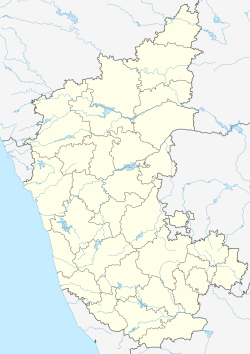| Chaturmukha Basadi, Gerusoppa | |
|---|---|
 Chaturmukha Basadi | |
| Religion | |
| Affiliation | Jainism |
| Sect | Digambara |
| Deity | Rishabhanatha, Ajitanatha, Sambhavanatha and Abhinandananatha |
| Festivals | Mahavir Jayanti |
| Location | |
| Location | Gerusoppa, Karnataka |
| Geographic coordinates | 14°13′43.4″N74°39′53″E / 14.228722°N 74.66472°E |
| Architecture | |
| Style | Western Chalukya architecture |
| Creator | Rani Chennabhairadevi |
| Date established | 1562 |
| Specifications | |
| Temple(s) | 5 |
| Materials | Grey granite |
Chaturmukha Basadi is a symmetrical Jain temple located in Gerusoppa in Honnavar Taluk of Uttara Kannada district in the Indian state of Karnataka. The temple is situated near the banks of the Sharavati. [1]


